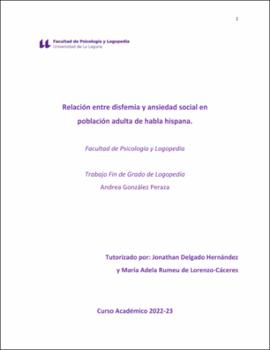Relación entre disfemia y ansiedad social en población adulta de habla hispana.
Author
González Peraza, AndreaDate
2023Abstract
El objetivo de este estudio es comparar la ansiedad social entre un grupo de personas que tartamudea
con otro que no. Como objetivos secundarios se pretende comparar en el grupo con disfemia los niveles
de ansiedad social en función del género, de los diferentes tipos de disfemia, de la asistencia al logopeda
y al psicólogo. Por último se estudia el efecto de la ansiedad social en la autopercepción de la tartamudez
en la vida diaria. Se pasó un cuestionario a 104 voluntarios y se dividieron en dos grupos, un grupo de
personas con disfemia (n=61) y otro grupo de personas sin disfemia (n=43). El cuestionario administrado
estaba compuesto por las variables sociodemográficas y la escala de ansiedad social de Liebowitz (LSAS).
El grupo con disfemia presenta puntuaciones de ansiedad social significativamente más altas que el grupo
sin disfemia (p<.001). No se encontraron diferencias entre géneros (p=.73). Dentro del grupo con disfemia
el tipo de disfemia tónico y mixto tenían puntuaciones mayores al resto. Asistir al logopeda y al psicólogo
no influye en los niveles de ansiedad social pero la autopercepción de la severidad de la tartamudez tiene
una relación positiva con la ansiedad social (𝑟𝑝 = .765, 𝑝 < .001). Las personas con disfemia presentan
niveles más altos de ansiedad social que las personas sin problemas de fluidez que se incrementan a
medida que aumenta negativamente la autopercepción de la gravedad de la disfemia. La disfemia tónica
y mixta son la que más se relacionan con los problemas de ansiedad social. The objective of this study is to compare social anxiety between a group of people who stutter and
another who do not stutter. As secondary objectives we pretend to compare in the group with
dysphemia the levels of social anxiety as a function of gender, the different types of dysphemia, the
attendance to the speech therapist and the psychologist. Finally, the effect of social anxiety on the selfperception of stuttering in daily life was studied. A questionnaire was passed to 104 volunteers and they
were divided into two groups, a group of people with dysphemia (n=61) and another group of people
without dysphemia (n=43). The questionnaire administered was composed of sociodemographic
variables and the Liebowitz social anxiety scale (LSAS). The group with dysphemia presented significantly
higher social anxiety scores than the group without dysphemia (p<.001). No differences were found
between genders (p=.73). Within the group with dysphemia the tonic and mixed dysphemia type had
higher scores than the rest. Attending the speech therapist and the psychologist did not influence the
levels of social anxiety but the self-perception of the severity of stuttering had a positive relationship
with social anxiety (𝑟𝑝 = .765 , 𝑝 < .001). People with dysphemia present higher levels of social anxiety
than people without fluency problems that increase as self-perceived severity of dysphemia increases
negatively. Tonic and mixed dysphemia are the most related to social anxiety problems.





